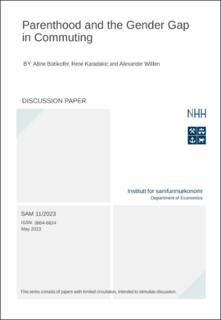| dc.contributor.author | Bütikofer, Aline | |
| dc.contributor.author | Karadakic, René | |
| dc.contributor.author | Willén, Alexander | |
| dc.date.accessioned | 2023-05-25T10:35:32Z | |
| dc.date.available | 2023-05-25T10:35:32Z | |
| dc.date.issued | 2023-05 | |
| dc.identifier.issn | 0804-6824 | |
| dc.identifier.uri | https://hdl.handle.net/11250/3068985 | |
| dc.description.abstract | Childbirth increases the opportunity cost of commuting and makes it difficult for both parents to work far away from home. Using detailed Norwegian register data, we show that the commuting patterns of men and women diverge immediately after childbirth and that those differences persist for at least a decade. We show that this divergence in commuting exposes mothers to more concentrated labor markets with fewer job opportunities and establishments of lower quality. These findings help explain the child penalty documented in the prior literature and have important implications for the design of policies seeking to address the remaining gender wage gap. | en_US |
| dc.language.iso | eng | en_US |
| dc.relation.ispartofseries | SAM DP;11/2023 | |
| dc.subject | Commuting, Gender Wage Gap, Parenthood | en_US |
| dc.title | Parenthood and the Gender Gap in Commuting | en_US |
| dc.type | Working paper | en_US |
| dc.source.pagenumber | 42 | en_US |
| dc.relation.project | Norges Forskningsråd: 262675 | en_US |
